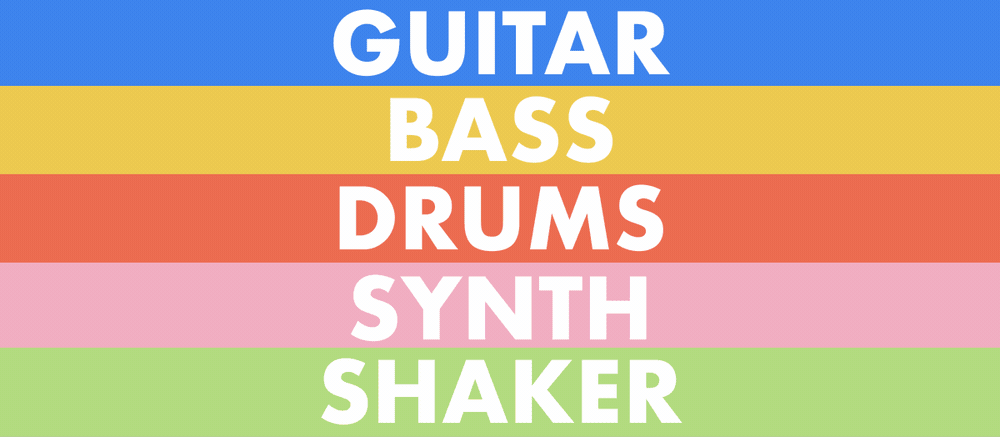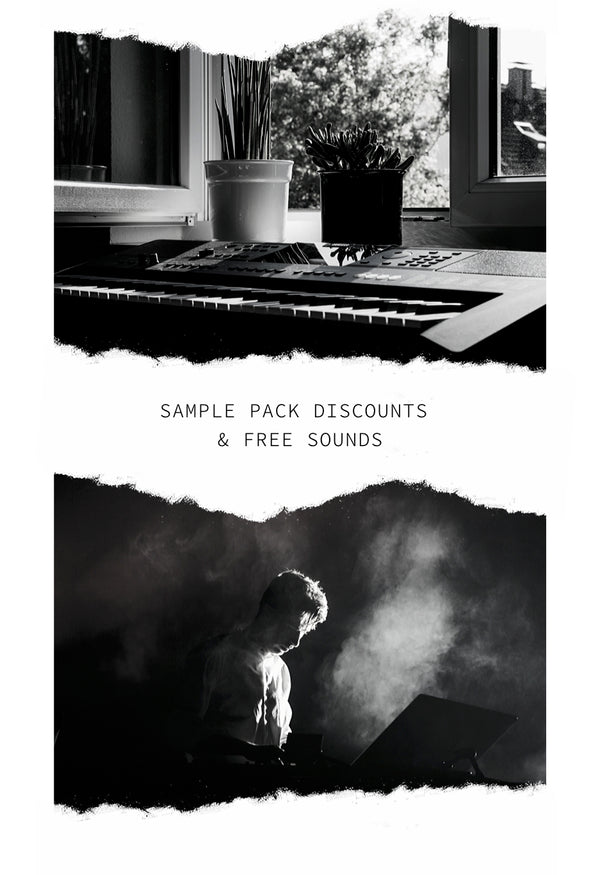Your Cart is Empty
⚠50% off code: SAMP50⚠
⚠50% off code: SAMP50⚠
⚠50% off code: SAMP50⚠
by Anders Johanson March 18, 2018 5 min read
Creating music is similar to creating a piece of art. It begins with a simple outline and structure, which is then filled in with vibrant colors, captivating textures, and captivating gradients of light and darkness. Finally, the finishing touches are added to bring the piece to life. Just as in art, making the correct decisions throughout the entire creative process, from composing the music to recording and arranging it, can significantly expedite the mixing process, produce a more refined track, and eliminate the need for adjustments during the mixing stage.
When combining sounds, there are two main factors to consider: the frequency profile of each sound and its amplitude over time. For instance, a plucked bass guitar note usually contains most of its sound energy in the low frequency range, with some higher frequencies occurring during the initial plucking. The note's envelope shape typically has a quick onset and a gradual decay. On the contrary, a gong smash has a wide range of frequencies, with a slow build-up and a prolonged sustain.
Over centuries, arrangers and composers have pondered the frequency composition of the various instruments they are orchestrating for. Acoustic instruments possess a specific frequency range determined by their physical dimensions and resonating tendencies, along with other contributing factors. Composers skillfully exploit these practical limitations. When crafting music for a string quartet, for instance, a composer intuitively comprehends the limitations of each instrument: the double bass capable of reaching incredibly low frequencies, while the violin's range extends into the uppermost registers. They meticulously score instrumental sections in a manner that complements one another, such as employing call and response dynamics between the lower and higher sections of the ensemble or employing exhilarating glissandos that commence in the lower registers and culminate with the highest notes.
the components of your mix to optimize the frequency balance and enhance the overall sound quality of your electronic compositions. This approach will not only elevate the professionalism of your finished tracks but also give you greater control over the tonal characteristics of your mix. Selecting and manipulating the different elements of your composition will enable you to create a cohesive and dynamic sonic experience for your listeners. instrumentsTo ensure that your sonic canvas is filled with a captivating blend of sounds, it is important to employ non-competing frequency profiles. This will keep the listener's ear engaged and intrigued. Additionally, it is advisable to avoid excessive use of a single instrument throughout the entire musical range, particularly when there is a multitude of elements in your arrangement.

Busy arrangements can be enthralling and exhilarating, but inundating your tracks with excessive instrumentation can be overpowering for the listener, not to mention challenging to mix. There exist multiple strategies for managing busy arrangements, but the initial crucial step always involves introspection - asking yourself, 'Is this part truly necessary?'. Being capable of honestly addressing this question constitutes the ultimate challenge for a skilled producer: emotionally separating oneself from the music that has been labored over and evaluating it with objectivity, thus leaving behind the most unadulterated artistic statement.
One effective strategy for ensuring that cherished passages remain present in your songs without overwhelming them is to experiment with the placement of your musical parts within your arrangement. Many musicians fall into the common mistake of cramming all their musical ideas into the beginning of a song in order to quickly reach a peak of energy, leaving little room for growth or development. If you find yourself trapped in this pattern, you can remedy it by spreading out your musical motifs throughout the arrangement, allowing the musical energy to gradually and dynamically build.
One more tip is to condense your musical concepts into simpler phrases. For instance, you might have a complex guitar segment spanning two bars that can be simplified into a few licks that fulfill the same purpose in the mix. By reducing the amount of sonic information, you will ultimately create more breathing room, a wider range of dynamics, and a greater impact in your overall mix.
By all means, if you have attempted to relocate or modify problematic elements and they continue to be out of place, you may have no alternative other than discarding them - the delete button can be your greatest ally in certain cases. However, do not dispose of your brilliant ideas permanently - establish an ideas folder that can serve as a source of inspiration for future occasions.

The unique quality of every sound can be determined by its attack, decay, sustain, and release. These parameters can be found on the amplitude envelope of a synthesizer or on dynamics processors. When you combine sounds with varying dynamic characteristics, you can alter their form. This technique can be employed to ensure that drums have a powerful impact without overpowering the overall mix, give leads a more prominent presence without dominating the other elements, and maintain a consistent sustain for tones.
Dynamic layering can be a laborious task. Imagine you are faced with the challenge of creating a powerful and impactful visual experience. 808 kick drumDAW most likely has one built-in). This will show you the frequency content of your kick and the subby sample. You can use this information to identify any overlapping frequencies and make adjustments accordingly. Next, you can use EQ to carve out space for the subby sample. You can reduce the frequencies in your kick that are also present in the sample, allowing the low-end of the subby sample to shine through. Experiment with different EQ settings to find the right balance. Another tool you can use is compression. By applying gentle compression to your kick and subby sample, you can control the dynamics and ensure they sit together nicely in the mix. You may also consider sidechain compression, where the kick triggers the compression on the subby sample, creating a pumping effect that gives the kick more room to breathe. Lastly, consider layering your kick with a sub-bass synthesizer. This will give you even more control over the low-end energy and allow you to create a unique and powerful sound. Experiment with different synthesizer settings and blend it with your kick until you achieve the desired result. In summary, adding low-end energy to your beat on a full-range sound system can be achieved by tuning and shaping a subby sample, using spectrum analysis, EQ, compression, and layering with a sub-bass synthesizer. With some experimentation and fine-tuning, you can create a unique and powerful sound while maintaining the character of your kick. DAWIt is highly probable that you will possess at least one (1) of these. Following that is a compressor; utilizing the utmost attack and release controls allows for a complete transformation of the amplitude envelope's profile. It is even possible to direct another instrument's output to the compressor's side-chain input, enabling the shaping of your new sample's dynamics through the signal of another instrument. Additionally, a transient designer tool is available, providing extensive control over all of the aforementioned features.
Don't forget that when you layer sounds, particularly those with low frequencies, it can lead to peculiar inconsistencies in EQ. This is caused by certain frequencies being emphasized and canceled out as they phase in and out with each other. It's important to closely analyze the frequency profile of your sounds and consider making small timing adjustments, either in your sampler or on the timeline. Remember, paying attention to these details will ensure a better overall sound quality.

multiple sound elements, it is essential to spread them out across the entire frequency spectrum. Concentrating all the sonic information in one area can result in a muddled and overwhelming mix. An effective approach is to distribute the sounds across different frequency ranges, ensuring each element has its own space to breathe and be heard. This not only prevents sonic clutter but also creates a more balanced and pleasant listening experience. So remember, avoid the sonic dump, embrace the art of layering, and achieve a harmonious mix that will be music to everyone's ears. If you want to combine the kick drum and bass in your mix, it's important to create a balance between them. One way to achieve this is by assigning specific frequency ranges to each instrument so that they do not overlap and compete for space. You can use a frequency analyzer to identify the most intense frequencies for each instrument and then allocate those frequencies exclusively to one of them. This way, only one instrument will occupy that frequency range at a time, preventing clashes. Additionally, you can employ other techniques to manage the interaction between the kick drum and bass. Syncopating their rhythm against each other is one effective method. By introducing offbeat patterns and variations in their timing, you can create a more dynamic and interesting interplay between the two elements. This prevents them from constantly playing together and helps to maintain clarity and separation in the mix.
One important tip is to pay close attention to your beloved songs and observe how musical instruments similar to the ones in your compositions are arranged. Are all the instruments played simultaneously? Do specific tones undergo noticeable filtration? Drawing inspiration from professionals when it comes to layering is absolutely acceptable.
by Anders Johanson January 30, 2021 11 min read
Read Moreby Anders Johanson January 18, 2021 9 min read
Read More
Get exclusive discount codes for sample packs, Grab amazing discounts for sample packs, Get free sounds delivered directly to your email inbox. Enjoy a wide variety of unique audio files right at your fingertips. Sign up now to never miss out on the latest sounds and updates. , in addition to other things! No joke, we distribute complimentary audio files!